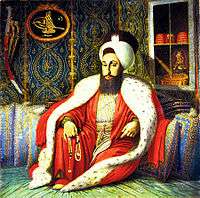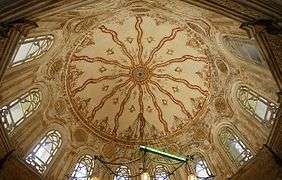Mihrişah Sultan (wife of Mustafa III)
Mihrişah Sultan (Ottoman Turkish: مهرشاہ سلطان; c. 1745 – 16 October 1805; meaning "Light of the King" in Persian), known as "the Georgian Beauty", was a consort of Sultan Mustafa III, and the mother of Sultan Selim III of the Ottoman Empire, and his de facto co-regent (as the Valide Sultan) for sixteen years from 1789 until 1805.
| Mihrişah Sultan | |||||
|---|---|---|---|---|---|
 | |||||
| Valide Sultan of the Ottoman Empire | |||||
| Tenure | 7 April 1789 – 16 October 1805 | ||||
| Predecessor | Şehsuvar Sultan | ||||
| Successor | Sineperver Sultan | ||||
| Born | Agnes c. 1745 Georgia | ||||
| Died | 16 October 1805 (aged 59–60) Constantinople, Ottoman Empire (present day Istanbul, Turkey) | ||||
| Burial | |||||
| Spouse | Mustafa III | ||||
| Issue | Selim III Hibetullah Sultan Fatma Sultan | ||||
| |||||
| House | Ottoman (by marriage) | ||||
| Father | Georgian Orthodox priest | ||||
| Religion | Sunni Islam | ||||
Early life
Of ethnic Georgian origin, she was born in 1745 in Georgia.[1][2] she was the daughter of a Georgian Orthodox priest.[3][4] She was beautiful,[5] and was called "the Georgian Beauty" (Turkish: Gürcü güzeli).[6][7] She received the name Mihr-î-Şah, meaning "Sun of the king" in Persian.
As imperial consort
Mihrişah married Mustafa after his accession to the throne in 1757, and was given the title of "Senior Consort".[8]
On 14 March 1759,[9] she gave birth to her first child, a daughter, Hibetullah Sultan.[10][11] For the past thirty years no child had been born in the imperial family, hence, Hibetullah’s birth was celebrated in the whole of Istanbul.[9] On 2 June 1759, when she was three months old, Mustafa engaged her to Mahir Hamza Pasha. She died on 7 June 1762, at the age of three.[12]
On 24 December 1761, she gave birth to her second child, a son, Şehzade Selim (future Selim III). His birth was accompanied by celebrations that lasted a week.[13][14] On 9 January 1770, she gave birth to her third child, a daughter, Fatma Sultan, who died at the age of two on 26 May 1772.[10][15]
Mihrişah was widowed at Mustafa's death in 1774, after which she settled in the Old Palace.[16][17]
As Valide Sultan
Selim's accession and political influence

During the reign of Sultan Abdul Hamid I, which lasted for fifteen years, Şehzade Selim remained closed in the Topkapı Palace, and the Mihrişah was sent to live in the Old Palace. Upon Abdul Hamid's death in 1789, Selim accended the throne after which Mihrişah became the Valide Sultan.
Selim had a thorough renovation of the part of the Harem circle of the Topkapı Palace for the sultans for his mother. It is rumored that Sultan Selim went to her apartment every day, chatted and discussed the city issues. Although Selim was extremely fond of his mother, Mihrişah never misused this, and was not involved in the administration and politics of the state. Therefore, there is not much information about it. Being an emotional, calm and gentle lady, Mihrişah has made history with her religiousness and philanthropy.[17]
She occasionly approached her son to beg a favour or an act of mercy.[16] When he launched his Nizam-I Cedid (New Order), both Mihrişah and her Kethüda, by then Yusuf Agha, were his strong supporters. To encourage the reforms so dear to her son's heart, Mihrişah built a mosque a mosque for the Humbaracıhane (barracks of the bombardiers) at Hasköy on the Asiatic sore, and founded a school of medicine at Üsküdar.[18]
Yusuf Agha was her second kethüda, who had replaced her first kethüda Mahmud Agha, when he died during tenure of his office.[19] He was capable, and an intimate of Selim. He was persuaded and finally killed by the machinations of Kabakçı Mustafa in the uprising against Selim in 1808, after which his tax farm was given to Sultan Mustafa IV's mother, Sineperver Sultan.[20]
Patroness of architecture
She founded many schools and mosques in the 1790s. In 1793, she founded Halıcıoğlu Mosque repaired and she repaired the Silahtar Yusuf Pasha Fountain in Kağıthane in 1794.[16]
The Humbarahane Barracks which were built in 1792 by Mihrişah, consisting of ball casting facilities, training sites, a chlorine house with leather for use for various military purposes, kitchen, stables, baths, legitimate rooms and shops with masjids, is considered the first modern example of large-scale military buildings. When it started to operate, the Hasköy side in the south was reserved for the riders and the Sütlüce side in the north was for the sewers. After the opening of the Engineer-i Berrî-i Hümâyun in 1795, the barracks included here were built in II. It was renovated during the reign of Mahmud and was given to Mekteb-i Tıbbiyye instead of Galata Palace, which was burned in 1848. [21]
In 1795, she founded the Mihrişah Valide Sultan School and Külliye in the region of Eyüp in Istanbul. In 1805, she ordered the construction of the Mihrişah Valide Sultan Fountain in Yeniköy in İstanbul. The imaret, which was built by the order of Mihrişah, is still in working order. She was the subject of a poem. Mihrişah and her son Selim were both members of the Mevlevi Order, which practiced Sufi whirling. In 1792, she built a fountain in the memory of her daughter Fatma Sultan.[22]
Mihrişah also built a dam. Ahmed Efendi, contains important information about the period from the beginning to the end of the construction of "Mihrişah Valide Sultan Dam". According to the information provided by Ahmed Efendi, the purpose of building the dam is to provide additional water supply to the Büyük Bent (Bend-i Kebr), which is within the scope of Kırkçeşme Waters and known as Tophâne Water, and the Tophâne Water. On the other hand, Topcıyân and Arabacıyân and Tophâne, Galata and Beşiktaş inhabitants in Tophâne during the summer days eliminate the water shortage.[23]
Vâlide Dam was built on the eastern branch of Arabacı Mandrai, which is one of the important streams of Istanbul in Bahçeköy, which is located within the borders of Sarıyer (Istanbul), and the Acıelma Stream, which is one of the most important rivers of Istanbul. After the construction of Valide Dam was completed, the water accumulated in the dam was included in the water of Topuzlu Dam with a medium made by Valide Sultan.[24] The amount of water added to Topuzlu Dam was accurately measured and determined to be 23 nozzles. These 23 nozzles have 16 nozzles of water from the Old Bent; however, it was decided to allocate it to places that could not receive their ration because of the insufficient water. The remaining 7 nozzles were left with 2 nozzles as the "right to media", while the other 5 nozzles were left to the saving Sultan of Valide Sultan to be distributed from the Beyoğlu Maksemi (Taksim Maksemi).[25]
Between the years of 1792-1803, one of them was in Boyacıköy and the other was in Küçüksu; In 1796, she built a fountain between Eminönü and Balıkpazarı to witness the spirit of Çaşnigir Zeynep, However, this fountain was later called Mihrişah Vâlide Fountain. A fountain in Kılıçali District in Beşiktaş in 1797; Two fountains on either side of the tomb built for her in Eyüp in 1801; A fountain in Üsküdar İhsaniye in 1791 in the memory of her daughter Hibetullah Sultan, and a fountain in Fındıklı Mollabayırı in 1797 and a fountain in Yeniköy in 1805 for her other daughter Fatma Sultan.[23] With the addition of Valide Bendi water to Taksim Waters Facilities, the amount of water has doubled, and as a result, the water needs of the people have been met to a large extent by making fountains in Beyoğlu, Galata and Boğaziçi neighbourhoods.[26]
Death
Mihrişah Sultan died on 16 October 1805 from an unknown disease and is buried in her mosque in her own mausoleum located at Eyüp, Istanbul.[27][17] Her daughter-in-law Refet Kadın the fourth wife of her son Selim III is buried beside her. [28]
Issue
Together with Mustafa, Mihrişah had three children:
- Hibetullah Sultan (14 March 1759 – 7 June 1762, buried in Mustafa III Mausoleum, Laleli Mosque, Istanbul), betrothed on 2 June 1759 to Mahir Hamza Pasha;
- Sultan Selim III (Topkapı Palace, 24 December 1761 – 28 July 1808, buried in Mustafa III Mausoleum), Sultan of the Ottoman Empire; married seven times without issue;
- Fatma Sultan (9 January 1770 – 26 May 1772, buried in Mustafa III Mausoleum, Laleli Mosque, Istanbul);
In popular culture
- In 1989 Swiss-American drama film The Favorite, Mihrişah is portrayed by French actress Andréa Parisy.[29]
- In 2012 Turkish miniseries Esir Sultan, Mihrişah is portrayed by Turkish actress Ipek Tenolcay.[30]
Gallery
 Dome of the mausoleum of Mihrişah Valide Sultan
Dome of the mausoleum of Mihrişah Valide Sultan Mausoleum of Mihrişah Valide Sultan
Mausoleum of Mihrişah Valide Sultan Mausoleum of Mihrişah Valide Sultan Sebili
Mausoleum of Mihrişah Valide Sultan Sebili
See also
- Ottoman dynasty
- Ottoman Imperial Harem
- List of Valide Sultans
- List of consorts of the Ottoman Sultans
- List of mothers of the Ottoman sultans
References
- Gabor Agoston; Bruce Alan Masters (1 January 2009). Encyclopedia of the Ottoman Empire. Infobase Publishing. p. 514. ISBN 978-1-4381-1025-7.
- E.J. Brill's First Encyclopaedia of Islam 1913-1936. BRILL. 31 December 1987. p. 1117. ISBN 90-04-08265-4.
- H. Mirgül Eren Griffe (2005). Galip Ali Paşa Rızvanbegovic-Stocevic. Babil. p. 55.
Ortodoks bir Gürcü papazın kızı olan Mihrişah
- Y. İzzettin Barış (2002). Osmanlı padişahlarının yaşamlarından kesitler, hastalıkları ve ölüm sebepleri. Bilimsel Tıp Yayınevi. p. 184. ISBN 978-975-6986-17-2.
Selim'in annesi olan Mihrişah, Gürcistan'dan kaçırılan bir papazın kızıydı
- Albert Hourani; Philip Shukry Khoury; Mary Christina Wilson (1 January 1993). The Modern Middle East: A Reader. University of California Press. p. 42. ISBN 978-0-520-08240-3.
beautiful Georgian slave-girl named Mihr-i Şāh
- Osmanlı tarihi: cilt. Nizam-ı cedid ve Tanzimat devirleri, 1789-1856. Türk Tarih Kurumu Basımevi. 1961. pp. 13, 16.
Gürcü güzeli Mihrişah
- Osman Horata (1998). Esrâr Dede: hayatı, şiir dünyası ve dı̂vânı. T.C. Kültür Bakanlığı. ISBN 978-975-17-1954-6.
Selim'in Gürcü güzeli ... annesi Mihrişah
- Kal'a, Ahmet (1998). İstanbul külliyâtı: İstanbul tarım tarihi, 1 (1743-1757), 2 (1757-1763). İstanbul Araştırmaları Merkezi. p. 218.
- Uluçay 2011, p. 151-2.
- İyianlar, Arzu (1992). Vâlide Sultanlar'ın İmar Faaliyetleri. İstanbul Üniversitesi Sosyal Bilimler Enstitüsü. pp. 167–8, 170–71.
- Dominic, Paulina D.; Roszak, Stanisław (2017). The Istanbul Memories in Salomea Pilsztynowa's Diary "Echo of the Journey and Adventures of My Life" (1760). pp. 52 n. 41.
- Uluçay 2011, p. 152.
- Başaran, Betül (14 July 2014). Selim III, Social Control and Policing in Istanbul at the End of the Eighteenth Century: Between Crisis and Order. BRILL. p. 72. ISBN 978-9-004-27455-6.
- Kazancıoğlu 2016, p. 95-6.
- Sakaoğlu, Necdet (2008). Bu mülkün kadın sultanları: Vâlide sultanlar, hâtunlar, hasekiler, kadınefendiler, sultanefendiler. Oğlak Yayıncılık. ISBN 978-9-753-29623-6.
- Uluçay 2011, p. 150.
- Kazancıoğlu 2016, p. 96.
- Davis 1986, p. 10-11.
- Davis 1986, p. 27 n. 77.
- Davis 1986, p. 9.
- "HUMBARAHANE KIŞLASI ve CAMİİ İstanbul'da Haliç kıyısında XVIII. yüzyılın sonlarına ait kışla ve cami". İslam Ansiklopedisi. Retrieved 11 May 2020.
- Uluçay 2011, p. 169.
- Kazancıoğlu 2016, p. 98.
- Kazancıoğlu 2016, p. 97.
- Kazancıoğlu 2016, p. 99.
- Kazancıoğlu 2016, p. 101.
- Uluçay 2011, p. 151.
- Akkurt 2018, p. 8.
- Full Cast & Crew: The Favorite (1989), retrieved 7 April 2020
- Full Cast & Crew: Esir Sultan (2012– ), retrieved 7 April 2020
Sources
- Uluçay, M. Çağatay (2011). Padişahların kadınları ve kızları. Ankara, Ötüken.
- Kazancıoğlu, Habibe (2016). Mihrişah Valide Sultan Su Bendi.
- Fanny Davis (1986). The Ottoman Lady: A Social History from 1718 to 1918. Greenwood Publishing Group. ISBN 978-0-313-24811-5.
- Akkurt, Ibrahim (2018). Mihrişah Vâlide Sultan ve Külliyesi.
External links

| Ottoman royalty | ||
|---|---|---|
| Preceded by Şehsuvar Sultan |
Valide Sultan 7 April 1789 – 16 October 1805 |
Succeeded by Sineperver Sultan |
